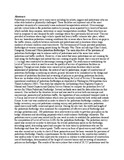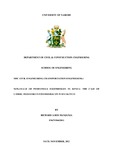| dc.description.abstract | Pedestrian overcrossings serve many users including bicyclists, joggers and pedestrians who are either able bodied or physically challenged. These facilities can represent one of the most important elements of a community’s non-motorized transportation network. Overcrossings provide critical links in the pedestrian system by joining areas separated by a variety of barriers which include deep canyons, waterways or major transportation corridors. These structures are built in response to user demand for safe crossings where they previously did not exist. They are provided at locations where high vehicle speeds and heavy traffic volumes take place, where there are hazardous pedestrian crossing conditions like in areas where there are few or no gaps in the traffic stream, conflicts between motorists and pedestrians and in locations where large numbers of school children cross busy streets. The Government of Kenya provided pedestrian footbridges at various crossing points along the Waiyaki Way. These include Aga Khan School, Kamgemi, Rironi and Uthiru pedestrian footbridges. The main objective of the provision of pedestrian footbridges was to enhance safety of pedestrians and at the same time reduce pedestrian and traffic conflicts. However, it was noted that some pedestrians are not crossing the road using the footbridges and instead they are crossing at grade despite that a concrete barrier of 1.2 m high was constructed to discourage crossing at grade. The study aims at establishing the Level of Service which is used to access the quality of service of operations facilities on highway. Though several studies were carried out on pedestrian facilities which include assessment of pedestrian facilities, the extent of use by pedestrians, impact of construction of pedestrian footbridge in reducing accidents, general warrants to be considered in the design and provision of pedestrian facilities and reviewing of policies in providing pedestrian facilities, there are no studies which researched on the establishing the Level of Service C for assessing operational conditions of pedestrian footbridges as stipulated in Washington Metropolitan Area Transit Authority (2005). This study has adapted the methodology from Highway Capacity Manual and Transit Capacity and Quality Service Manual to compute the pedestrian level of service for Uthiru Pedestrian Footbridge.
Several methods were used for data collection on this research. One method is the literature review and was used to review both microscopic and macroscopic parameters of pedestrian traffic, the legislation of non-motorised transport mode in
vi
Kenya and review of related studies which were previously conducted both within and outside Kenya. A site visit was conducted in order to observe the pedestrian footbridge condition, collect bridge inventory, carry out pedestrian counting survey, oral pedestrian interview, pedestrian speed survey and traffic count and speed surveys. During the site visit, the width and length of the pedestrian footbridge were measured for computation of effective area of footbridge and average pedestrian area. 200 pedestrians were interviewed in order to get their perception on the bridge utilization and identifying proposals which could enhance footbridge utilization. The pedestrian survey count was carried out for one week in order to establish the pedestrian demand for computation of Level of Service (LOS) for the pedestrian footbridge. The pedestrian survey speed was carried out in order to determine the overall pedestrians speed on the footbridge, ascending speed, descending speed and compare the time taken by pedestrians who use the footbridge and those that cross at grade. Traffic survey in form of speed survey and traffic count was also carried out in order to check if these parameters meet the basic warrants for provision of pedestrian footbridge. Finally, a questionnaire for the stakeholders in the construction industry was used in order to have their input into the research in relation to establishment of construction cost of footbridges, determination of the height of concrete barrier and reviewing of maintance policies on footbridges. The results of the survey show that a total of 29,727 pedestrians used the footbridge from Monday to Sunday. A total of 9,045 pedestrians used the footbridge during the weekend representing 30% of number of pedestrians who used the pedestrian footbridge for the whole week. Only 5 cyclists used the footbridge representing less than 1%. Female pedestrians used the footbridge most followed by children and men respectively. The results further show that 10% of the pedestrians crossed the highway at grade instead of using the footbridge. 1,326 pedestrians crossed at grade during the weekend representing 45%. Most pedestrians who crossed at grade were men with over 90% and the rate was high for grade crossing over the weekend especially on Saturday. This was the case because this is a market day at Kamgemi and Kawangware; hence most traders go and buy their products for Uthiru make shift markets.
The pedestrian survey count showed that the highest pedestrian peak volume was on Monday from 17.00-18.00 registering 1,006 pedestrians followed by 923
vii
pedestrians who were recorded on Thursday from17.00-18.00. The lowest pedestrian demand was recorded on as 254 pedestrians on Thursday from 12.00-13.00. The LOS of the footbridge ranged from LOS E and F respectively. This meant that the pedestrian footbridge was not operating at the recommended LOS C or B. The average area for each pedestrian was found to be 0.22 m2/pedestrian which was less that 0.3 m2 for simplified body ellipse of 0.5m x 0.6 m and recommended area of 0.75 m2 for buffer zone for each pedestrian (HCM, 2000). The current effective width of the footbridge is 2.2 m and the designed required effective footbridge width was computed as 3.65 m. This design footbridge width was determined with respect to the impact of usage of footbridge by other NMT modes such as cyclist and microscopic parameters of pedestrian traffic stream. In terms of legislation, it was observed that though the Traffic Act Chapter 403 recognizes non motorized transport and pedestrianization mode of transport, the act does not state if crossing at non-designated crossing points amounts to an offence. Local Government Act Chapter 265, empowers authorities to make by-laws on various aspects including safety of pedestrians. Though the City Council of Nairobi has bylaws as General Nuisance Bylaws, the bylaws do not include specific by-laws on jay walking and do not have details of fines for offenders. The recommendations of the study include both long term and short term solutions based on the survey results on general perception of pedestrians on footbridge usage, reasons which they feel contributed to non-usage of footbridge and proposals which should be implemented as one way of increasing utilization levels of the footbridge. Short term solutions include improvement of maintance, provision of lighting powered by solar, barring vending on pedestrian footbridge, installation of road signs and erection of barrier leading to pedestrian footbridge to deter jay crossing. Long term solutions include some of the proposals which were made by pedestrians which should be considered in future projects but cannot be implemented on the existing footbridge because of the technical and financial implications. These include increasing height of the concrete barrier, increasing the width of the footbridge and upgrading footbridge staircase with ramps. As part of improving on the legislation, the study recommends that City Council of Nairobi should review the General Nuisance Bylaws, to include specific by-laws on jay walking and propose fines for offenders. The City Council should also improve on enforcement of the by-laws as well. | en |


